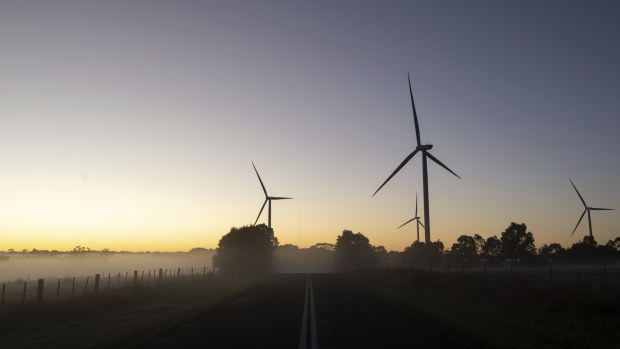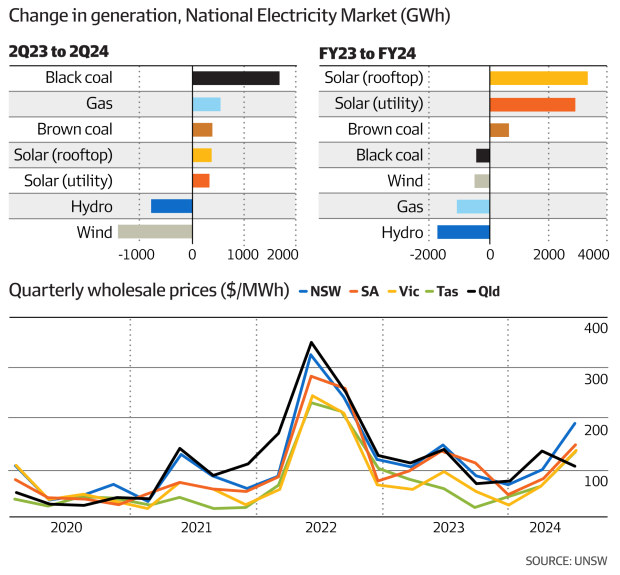
 











.gif)
|
Signature Sponsor


July 6, 2024 - Coal power staged a major resurgence in the June quarter, recording its first year-on-year growth in almost a decade amid a “drought” in wind power and increased demand, underscoring the disarray of the country’s transition to low-carbon energy. Data compiled by UNSW senior research associate Dylan McConnell shows a 6.5 percent increase in coal power generation across the National Electricity Market in the April-June period from a year earlier, wrecking the downward trend in emissions from the sector.
Wind turbines are susceptible to lulls in wind speeds for days or weeks at a time. Penny Stephens
The unexpected comeback of coal has put another dent in hopes of a smooth move away from fossil fuels for electricity supply and has underscored the extent to which energy security still relies on coal when weather conditions are unfavourable for renewables. Rystad Energy senior analyst David Dixon said in a LinkedIn post that the wind drought resulted in the NSW fleet of coal power stations – owned by Origin Energy, AGL Energy, EnergyAustralia and Delta Electricity – running at its highest capacity in 13 years in June, at 77 percent. The data adds further fuel to the raging political debate around whether Australia needs nuclear power to provide a clean source of baseload power to support renewables when coal power plants eventually close, making the system less reliant on the vagaries of the weather. Independent consultant Matthew Rennie said it was “no surprise” that coal is returning to the mix more prominently given the factors at play. “Renewables are neither being built as quickly as we need them to be, nor is transmission being constructed as quickly as required,” he said. “We are entering a phase where meeting society’s expectations of at least two limbs of the energy trilemma – energy price and security – will be contingent on the weather.” Generation from black coal power plants – located in NSW and Queensland – had the biggest year-on-year increase. June quarter output was some 1600 gigawatt-hours higher than in the same period last year, an increase of 7.3 percent, according to data compiled by UNSW senior research associate Dylan McConnell. In percentage terms, gas power experienced the biggest lift in the mix, of 16.5 percent, while brown coal output – from Victoria’s highly carbon-intensive plants – rose 4.4 percent. Generation from wind, in contrast, slumped 19.8 percent. Output in the quarter was about 1400 gigawatt-hours lower than the year-earlier quarter. Low wind power – which came despite significant investment in new wind farms – was a major factor behind last month’s squeeze on east coast gas supplies when spot prices rose to their highest in more than a year in some states. Electricity market watcher Global-ROAM calculated in late June that generation from wind farms for the quarter so far was roughly flat compared with the same quarter in 2021. This is despite about 2500 megawatts of wind capacity having been added. Solar power, meanwhile, was “ticking along, but at much slower growth rates than previously”, Dr McConnell said. Coal outputs ‘increase’The findings are supported by an analysis of NEM data by Geoff Eldridge at consultancy Global Power Energy, who put the increase in black coal power in NSW at 6.33 percent in the June quarter, and in Queensland at 8.33 percent. Gas power soared higher in NSW, Victoria and Tasmania, while falling sharply in Queensland, Mr Eldridge wrote in a LinkedIn post. He calculated a huge 31.3 percent drop in wind power in Victoria and a 20.1 percent drop in South Australia. “Coal and gas outputs have generally increased, reflecting a continued reliance on traditional energy sources to maintain grid reliability,” wrote Eldridge.
“Meanwhile, renewable energy sources such as utility wind and utility solar have faced declines due to seasonal challenges.” On an annual basis, solar power still grew strongly in 2023-24, with rooftop generation up 16.3 percent and solar farm output up 22.3 per cent, according to UNSW. But the annual figures show a stall in the decline of coal power, despite the closure of AGL’s Liddell plant in April last year. One Saturday last September, coal generation hit a fresh low of less than 35 percent of the mix in the NEM amid abundant rooftop solar output. That is less than half the rate the NSW power stations ran at last month. Dr McConnell said that in aggregate, coal power generation was very slightly up in 2023-24, by about 318 gigawatt-hours or 0.3 percent, but flat when factoring in the extra day in 2024’s leap year. “Flat is of course not good enough in terms of reducing emissions,” Dr McConnell said, noting that the latest projections from the Department of Climate Change, Energy, the Environment and Water have emissions in the NEM dropping 11.75 million tonnes, or about 9.5 percent, between FY23 and FY24. “Poor performance of wind farms is also part of the story – but it’s also reflective of not building out new renewable energy capacity fast enough,” he said. Volatile power prices Meanwhile, wholesale power prices rose sharply in the June quarter from a year earlier in all states in the NEM apart from Queensland. NSW had the highest prices, with prices shooting up 28 percent to $189.15 a megawatt-hour, while spot prices in Victoria jumped 44.5 percent to $138.70 a megawatt-hour. In Tasmania, which was forced to switch on a gas power plant in June for the first time since 2019 due to an extended dry spell, prices more than doubled to $135.70 a megawatt-hour, according to UNSW. In Queensland, prices dropped 21.6 per cent to $108.90 a megawatt-hour. Lisa Zembrodt, principal at Schneider Electric, said prices were likely to become more volatile as the share of generation coming from renewables grows, making them more sensitive to the weather. But she pointed to several supply projects due for completion in the next 12 months which should add downward pressure, while the hydro situation may improve in Tasmania. “In our view, movements are not all going to be up, we expect there will be periods with lower prices, just as seen in 2023,” Zembrodt said. “Due to the increased cost of gas, the market will be more sensitive to a shortage in either hydro or coal-fired output for balancing renewable energy, and more sensitive to demand as well.” |
 











|

